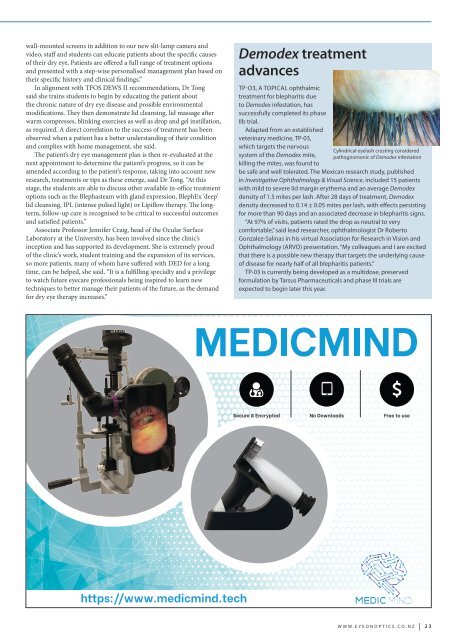You also want an ePaper? Increase the reach of your titles
YUMPU automatically turns print PDFs into web optimized ePapers that Google loves.
wall-mounted screens in addition to our new slit-lamp camera and<br />
video, staff and students can educate patients about the specific causes<br />
of their dry eye. Patients are offered a full range of treatment options<br />
and presented with a step-wise personalised management plan based on<br />
their specific history and clinical findings.”<br />
In alignment with TFOS DEWS II recommendations, Dr Tong<br />
said she trains students to begin by educating the patient about<br />
the chronic nature of dry eye disease and possible environmental<br />
modifications. They then demonstrate lid cleansing, lid massage after<br />
warm compresses, blinking exercises as well as drop and gel instillation,<br />
as required. A direct correlation to the success of treatment has been<br />
observed when a patient has a better understanding of their condition<br />
and complies with home management, she said.<br />
The patient’s dry eye management plan is then re-evaluated at the<br />
next appointment to determine the patient’s progress, so it can be<br />
amended according to the patient’s response, taking into account new<br />
research, treatments or tips as these emerge, said Dr Tong. “At this<br />
stage, the students are able to discuss other available in-office treatment<br />
options such as the Blephasteam with gland expression, BlephEx ‘deep’<br />
lid cleansing, IPL (intense pulsed light) or Lipiflow therapy. The longterm,<br />
follow-up care is recognised to be critical to successful outcomes<br />
and satisfied patients.”<br />
Associate Professor Jennifer Craig, head of the Ocular Surface<br />
Laboratory at the University, has been involved since the clinic’s<br />
inception and has supported its development. She is extremely proud<br />
of the clinic’s work, student training and the expansion of its services,<br />
so more patients, many of whom have suffered with DED for a long<br />
time, can be helped, she said. “It is a fulfilling specialty and a privilege<br />
to watch future eyecare professionals being inspired to learn new<br />
techniques to better manage their patients of the future, as the demand<br />
for dry eye therapy increases.”<br />
Demodex treatment<br />
advances<br />
TP-O3, A TOPICAL ophthalmic<br />
treatment for blepharitis due<br />
to Demodex infestation, has<br />
successfully completed its phase<br />
IIb trial.<br />
Adapted from an established<br />
veterinary medicine, TP-03,<br />
which targets the nervous<br />
Cylindrical eyelash crusting considered<br />
system of the Demodex mite, pathognomonic of Demodex infestation<br />
killing the mites, was found to<br />
be safe and well tolerated. The Mexican research study, published<br />
in Investigative Ophthalmology & Visual Science, included 15 patients<br />
with mild to severe lid margin erythema and an average Demodex<br />
density of 1.5 mites per lash. After 28 days of treatment, Demodex<br />
density decreased to 0.14 ± 0.05 mites per lash, with effects persisting<br />
for more than 90 days and an associated decrease in blepharitis signs.<br />
“At 97% of visits, patients rated the drop as neutral to very<br />
comfortable,” said lead researcher, ophthalmologist Dr Roberto<br />
Gonzalez-Salinas in his virtual Association for Research in Vision and<br />
Ophthalmology (ARVO) presentation. “My colleagues and I are excited<br />
that there is a possible new therapy that targets the underlying cause<br />
of disease for nearly half of all blepharitis patients.”<br />
TP-03 is currently being developed as a multidose, preserved<br />
formulation by Tarsus Pharmaceuticals and phase III trials are<br />
expected to begin later this year.<br />
WWW.EYEONOPTICS.CO.NZ | 23

















